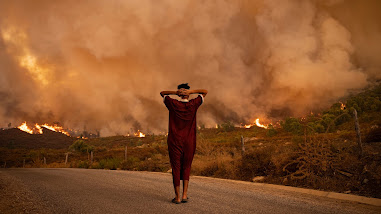
Global warming is having significant impacts on India, affecting various aspects of the country’s environment, economy, and society. Here are some key points on how global warming is influencing India:
Global Warming In India | Climate change And Agriculture In Global Warming
Climate and Weather Patterns
Rising Temperatures: India has experienced an increase in average temperatures over the past century. Heatwaves have become more frequent and intense, posing health risks and impacting agriculture.
Monsoon Variability: The Indian monsoon, which is crucial for the country’s agriculture, has become more unpredictable. Changes in monsoon patterns can lead to either excessive rainfall or droughts, both of which can devastate crops.
Environmental Impacts
Melting Glaciers: The Himalayan glaciers, which feed major rivers like the Ganges, are retreating due to rising temperatures. This threatens water supplies for millions of people and can lead to increased flooding initially followed by reduced river flows in the long term.
Sea Level Rise: Coastal areas in India, including major cities like Mumbai and Kolkata, are at risk due to rising sea levels. This can lead to increased flooding, erosion, and displacement of communities.
Agriculture and Food Security
Crop Yields: Changes in temperature and rainfall patterns can adversely affect crop yields. For example, heat stress can reduce the productivity of staple crops like wheat and rice.
Water Scarcity: Increased evaporation and altered rainfall patterns contribute to water scarcity, impacting both agriculture and drinking water supplies.
Health Impacts
Heat-related Illnesses: Higher temperatures increase the risk of heat-related illnesses and mortality. Vulnerable populations, including the elderly and children, are particularly at risk.
Vector-borne Diseases: Changes in climate can expand the range of vector-borne diseases like malaria and dengue fever, putting more people at risk.
Economic Impacts
Agricultural Economy: As agriculture is a significant part of India’s economy, any adverse effects on crop production can have broad economic repercussions, affecting livelihoods and food prices.
Infrastructure Damage: Increased frequency of extreme weather events, such as floods and cyclones, can damage infrastructure, leading to significant economic costs for repairs and reconstruction.
Mitigation and Adaptation Efforts
Renewable Energy: India is investing in renewable energy sources like solar and wind power to reduce greenhouse gas emissions. Initiatives like the International Solar Alliance aim to promote solar energy globally.
Climate Resilience: The government and various organizations are working on building climate resilience through measures like improved water management, sustainable agriculture practices, and infrastructure designed to withstand extreme weather.
Policy and International Cooperation: India is actively participating in international climate agreements, such as the Paris Agreement, and has committed to reducing its carbon intensity and expanding its renewable energy capacity.
Conclusion
Global warming poses significant challenges for India, but through concerted efforts in mitigation, adaptation, and sustainable development, the country aims to address these issues and build a more resilient future. The intersection of policy, innovation, and community action is crucial in combating the effects of climate change in India.









